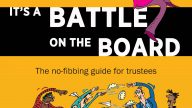Policy, Government and the Voluntary Sector
Regulator changing the data it collects on charities – have your say!
Here's everything you need to know about the Charity Commission’s consultation on the next version of the Annual Return.
If you’re a trustee or in charge of running a charity, especially if you perform a role like Treasurer, Secretary, or Finance Director, we’re urging you to respond to the Charity Commission’s consultation on the next version of the Annual Return, which is open until 1 September.
The Annual Return collects key information from charities above £10,000 annual income, and all Charitable Incorporated Organisations (CIOs). Charities with higher levels of income and certain types of activities also have to submit additional, more complex information. Together with other sources of data like charity reports and accounts, the Annual Return helps populate information on the public Register of Charities.
So, even if you’re a very small charity these changes could affect you, and the Charity Commission wants to hear your views – now’s your chance to tell them what you think. Without your input, you might find yourself burdened with too many questions that are too hard to answer the next time reporting season comes around!
Why is the Annual Return changing?
The questions on the Annual Return were last amended in 2018, so it’s been a few years. In the meantime, we’ve had Brexit, safeguarding scandals, a pandemic, and a cost-of-living crisis. Thinking in the Commission is evolving about how to better use data to identify regulatory issues in the sector, and to better respond to more widespread problems.
Data held by the regulator is one of the most important resources to understand charitable activity, and it can always be improved. On the other hand, any changes to what is collected need to be considered in the context of the regulatory burden it imposes both individually and collectively, set against any potential benefits.
The proposed version of the Annual Return would increase the number of questions, though the Commission says this is counterbalanced by simplifying some existing questions that were complex and which user feedback suggested were difficult to answer. The current version includes 16 questions for charities under £500k annual income, with a number of these also triggering follow up options or questions depending on the answer so that the respondent might eventually answer 32 questions.
The core of the new version for 2023 would include 36 questions extending to a possible 52 questions depending on the answer. That seems like a big increase, but these have been revised to be predominantly yes/no questions instead of more complex options, so the overall length of the ‘form’ is likely to be similar. In reviewing pdf versions of the current and new versions, they appear around the same length, but it’s not clear whether the length of time it takes to complete the new version would increase or decrease.
That’s why it will be particularly helpful for the Commission to have your feedback about the size of the task in addition to any particular problems with certain questions, especially from respondents tasked with completing the Annual Return for their charity.
What’s changing?
There’s too much detail to explain here in full, but sifting through the new version and comparing it to the revised one, it seems that the Commission wants more data about the following areas, likely because it has identified them as potential sources of risk across different types of charities:
- Sources of the charity’s income
- Overseas activities or operations
- ‘Connected parties’ – for example trustees, donors, and their relatives
- ‘Events’ that have impacted the charity’s ability to operate effectively – like a pandemic
For example, under the section for reporting income, the Commission wants to know whether more than 25% of the charity’s income was from an individual, corporate funder, foundation or ‘connected party’, and whether more than 70% was from a single source. It also wants more information about overseas income and the type of financial transactions.
In terms of the charity’s operations, it wants to know more precise information about the charity’s geographical areas of operation, in particular any overseas operations, as well as the existence of formal written agreements with overseas partners, and the location of its website hosting.
Will the changes be worth it?
Most of the ‘new’ questions appear to be for the Commission’s own analysis rather than for publication on the Register; the consultation makes clear that for now at least the types of new questions described above would be for internal use. Though it’s always possible that could change in the future. Some of the questions could yield really useful data, but it’s unclear whether they will be able to be answered in a consistent or efficient fashion. For example, a question about the premises of service delivery asks for relevant addresses. At an aggregated level, this could help illustrate the geographical pattern of service provision across the country, and to counteract the longstanding ‘headquarters problem’ with charity data – that a charity’s registered address is often not where the charitable activity actually takes place.
However, in many individual cases this might be too difficult to answer accurately. What if the charity provides services depending on where demand is, and the premises shift throughout the year? What if they provide them centrally to people all over the country? Without clear guidance and illustrative examples, preparers of the Annual Return might be tearing their hair out.
DSC will be responding to the consultation in due course, and we’d love to hear your what you think – please email us at [email protected]. Plus, stay tuned to our bulletin and @DSC_Charity for more in the coming months.


